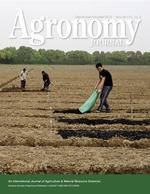Ver ítem
- xmlui.general.dspace_homeCentros Regionales y EEAsCentro Regional Santa FeEEA OliverosArtículos científicosxmlui.ArtifactBrowser.ItemViewer.trail
- Inicio
- Centros Regionales y EEAs
- Centro Regional Santa Fe
- EEA Oliveros
- Artículos científicos
- Ver ítem
Exploring nitrogen limitation for historical and modern soybean genotypes
Resumen
The United States (USA) and Argentina (ARG) account for over 50% of the global soybean [Glycine max (L.) Merr.] production. Soybean N demand is partially met (50–60%) by the biological nitrogen fixation (BNF) process; however, an unanswered scientific knowledge gap exists on the ability of the BNF process to fulfill soybean N demand at varying yield levels. The overall objective of this study is to explore the potential N limitation using different N
[ver mas...]
The United States (USA) and Argentina (ARG) account for over 50% of the global soybean [Glycine max (L.) Merr.] production. Soybean N demand is partially met (50–60%) by the biological nitrogen fixation (BNF) process; however, an unanswered scientific knowledge gap exists on the ability of the BNF process to fulfill soybean N demand at varying yield levels. The overall objective of this study is to explore the potential N limitation using different N strategies for historical and modern soybean genotypes. Four field experiments were conducted during 2016 and 2017 growing seasons in Kansas (USA) and Santa Fe (ARG). Twenty-one historical and modern soybean genotypes released from the 1980s to 2010s were tested under three N treatments: (i) control, without N application (Zero-N); (ii) 56 kg N ha–1 applied at R3-R4 growth stages (Late-N); and (iii) 670 kg ha–1 equally split at planting, R1, and R3–R4 growth stages (Full-N). Historical soybean yield gains, from the 1980s to 2010s, were 29% in the USA and 21% in ARG. Following the yield trend, seed N content increased for modern genotypes in parallel to the reduction on seed protein concentration. Regarding N treatments, Full-N produced 12% yield increase in the USA and 4% in ARG. Yield improvement was mainly related to increases in aboveground biomass, seed number (genotype effect), and to a lesser extent, to seed weight (N effect). This study suggests a potential N limitation for soybean, although there are still questions about the way in which N must be provided to the plant.
[Cerrar]

Autor
Ortez, O.A.;
Salvagiotti, Fernando;
Enrico, Juan Martin;
Prasad, P.V.V.;
Armstrong, P.;
Ciampitti, Ignacio A.;
Fuente
Agronomy Journal 110 (5) : 2080-2090 (2018)
Fecha
2018-10
Editorial
American Society of Agronomy
ISSN
0002-1962
1435-0645
1435-0645
Formato
pdf
Tipo de documento
artículo
Palabras Claves
Derechos de acceso
Abierto
 Excepto donde se diga explicitamente, este item se publica bajo la siguiente descripción: Creative Commons Attribution-NonCommercial-ShareAlike 2.5 Unported (CC BY-NC-SA 2.5)
Excepto donde se diga explicitamente, este item se publica bajo la siguiente descripción: Creative Commons Attribution-NonCommercial-ShareAlike 2.5 Unported (CC BY-NC-SA 2.5)


